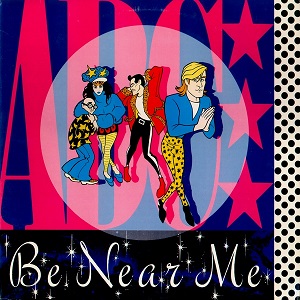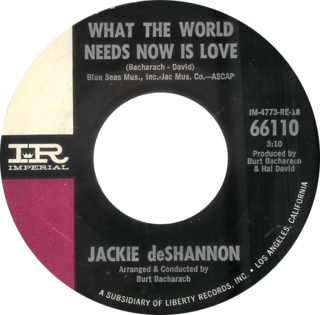Related Research Articles

"Promised Land" is a song lyric written by Chuck Berry to the melody of "Wabash Cannonball", an American folk song. The song was first recorded in this version by Berry in 1964 for his album St. Louis to Liverpool. Released in December 1964, it was Berry's first single issued following his prison term for a Mann Act conviction. The record peaked at #41 in the Billboard charts on January 16, 1965.
"What Is This Thing Called Love?" is a 1929 popular song written by Cole Porter, for the musical Wake Up and Dream. It was first performed by Elsie Carlisle in March 1929. The song has become a popular jazz standard and one of Porter's most often played compositions.

"Mr. Sandman" is a popular song written by Pat Ballard and published in 1954. It was first recorded in May of that year by Vaughn Monroe & His Orchestra and later that year by the Chordettes and the Four Aces. The song's lyrics convey a request to "Mr. Sandman" to "bring me a dream" – the traditional association of the folkloric figure. The pronoun used to refer to the desired dream is often changed depending on the sex of the singer or group performing the song, as the original sheet music publication, which includes male and female versions of the lyrics, intended.

"It's Your Thing" is a funk single by The Isley Brothers. Released in 1969, the anthem was an artistic response to Motown chief Berry Gordy's demanding hold on his artists after the Isleys left the label in late 1968.
"Too Young" is a popular song. The music was written by Sidney Lippman, the lyrics by Sylvia Dee. The song was published in 1951.
"Red Sails in the Sunset" is a popular song. Published in 1935, its music was written by Hugh Williams with lyrics by prolific songwriter Jimmy Kennedy. The song was inspired by the "red sails" of Kitty of Coleraine, a yacht Kennedy often saw off the northern coast of Northern Ireland and by his adopted town Portstewart, a seaside resort in County Londonderry.
"(Ghost) Riders in the Sky: A Cowboy Legend" is a cowboy-styled country/western song written in 1948 by American songwriter, film and television actor Stan Jones.
"Deep Purple" was the biggest hit written by pianist Peter DeRose, who broadcast, 1923 to 1939, with May Singhi as "The Sweethearts of the Air" on the NBC radio network. "Deep Purple" was published in 1933 as a piano composition. The following year, Paul Whiteman had it scored for his suave "big band" orchestra that was "making a lady out of jazz" in Whiteman's phrase. "Deep Purple" became so popular in sheet music sales that Mitchell Parish added lyrics in 1938.

"Different Drum" is a song written by American singer-songwriter Michael Nesmith in 1964. It was first recorded by the northern bluegrass band The Greenbriar Boys and included on their 1966 album Better Late than Never! Nesmith offered it to the Monkees, but the producers of the TV show, who had wide control over the group's musical output early on, turned him down.
"Cotton Fields " is a song written by American blues musician Huddie Ledbetter, better known as Lead Belly, who made the first recording of the song in 1940.

"Mule Skinner Blues" is a classic country song written by Jimmie Rodgers and George Vaughan. The song was first recorded by Rodgers in 1930 and has been recorded by many artists since then, acquiring the de facto title "Mule Skinner Blues" after Rodgers named it "Blue Yodel #8".

"Don't You Worry 'bout a Thing" is a single by Stevie Wonder from his 1973 album Innervisions. It reached number 16 on the Billboard Pop Singles chart, number 10 on the Cash Box chart, and number 2 on the R&B chart. The song's lyrics convey a positive message, focusing on taking things in one's stride and accentuating the positive. In 1992, British band Incognito had a European hit with their cover of the song.

"Don't Let Me Be Misunderstood" is a song written by Bennie Benjamin, Horace Ott and Sol Marcus for the American singer-songwriter and pianist Nina Simone, who recorded the first version in 1964. "Don't Let Me Be Misunderstood" has been covered by many artists. Two of the covers were transatlantic hits, the first in 1965 by The Animals, which was a blues rock version; and a 1977 by the disco group Santa Esmeralda, which was a four-on-the-floor rearrangement. A 1986 cover by new wave musician Elvis Costello found success in Britain and Ireland.

"Be Near Me" is a song by English new wave and synth-pop band ABC. It was released in April 1985 as the second single from their third studio album, How to Be a ... Zillionaire! It peaked at No. 26 on the UK Singles Chart in 1985, and was the only single from the album to reach the UK top 40. It was more successful in the United States where it reached No. 9 on the Billboard Hot 100. The song also went to number-one on the U.S. Hot Dance Club Play chart in September of that year, remaining on top for two weeks.

"What the World Needs Now Is Love" is a 1965 popular song with lyrics by Hal David and music composed by Burt Bacharach. First recorded and made popular by Jackie DeShannon, it was released on April 15, 1965, on the Imperial label after a release on sister label Liberty records the previous month was canceled. It peaked at number seven on the US Hot 100 in July of that year. In Canada, the song reached number one.
"He'll Have to Go" is an American country and pop hit recorded on October 15, 1959, by Jim Reeves. The song, released in the fall of 1959, went on to become a hit in both genres early in 1960.
"Someday You'll Want Me to Want You" is a popular song published in 1944 by Jimmie Hodges. The song became a standard, recorded by many pop and country music singers.
"Most Likely You Go Your Way and I'll Go Mine" is written and recorded by Bob Dylan for his 1966 album Blonde on Blonde. He released the song as a single twice during his career, once in 1974, which reached number 66 on the US chart, and again in 2007, appearing at number 51 on the UK chart.

"Part-Time Love" is a song written by English musician Elton John with lyrics by Gary Osborne. It is the sixth track off his 1978 album, A Single Man. It is also the opening track of side two. It proved to be one of the most popular singles the pair wrote, along with 1982's "Blue Eyes" and the 1980 US million seller "Little Jeannie". It was banned in the Soviet release of the album along with another song, "Big Dipper". The single reached No. 15 in the UK and peaked just outside the Top 20 in the US at No. 21.
"Indian Summer" is an American standard originally written as a piano piece by the prolific composer Victor Herbert. Al Dubin wrote lyrics for the tune in 1939, twenty years after Herbert wrote the tune.
References
- ↑ Shaw, Arnold (1987). The Jazz Age: Popular Music in the 1920s. New York: Oxford University Press. p. 113. ISBN 0195038916.
- ↑ "Definition of YONDER". www.merriam-webster.com. Retrieved 2017-11-18.
- ↑ Whitburn, Joel (1986). Joel Whitburn's Pop Memories 1890-1954 . Menomonee Falls, Wisconsin: Record Research Inc. p. 494. ISBN 0-89820-083-0.
- ↑ Murrells, Joseph (1978). The Book of Golden Discs (2nd ed.). London: Barrie and Jenkins Ltd. p. 19. ISBN 0-214-20512-6.
- ↑ Whitburn, Joel (1973). Top Pop Records 1940-1955. Record Research.
- ↑ "Most Played Juke Box Records" (PDF). Billboard. 63 (43): 38. October 27, 1951. Retrieved December 11, 2016.
- ↑ "Top Singles". Cash Box . December 15, 1951. Archived from the original on December 20, 2016. Retrieved December 11, 2016.
- ↑ Whitburn, Joel (2013). Joel Whitburn's Top Pop Singles, 14th Edition: 1955-2012. Record Research. p. 438.
- ↑ "officialcharts.com". officialcharts.com. Retrieved December 14, 2021.
- Bibliography
- Shaw, Arnold (1987). The Jazz Age: Popular Music in the 1920s . New York: Oxford University Press. ISBN 0195038916.